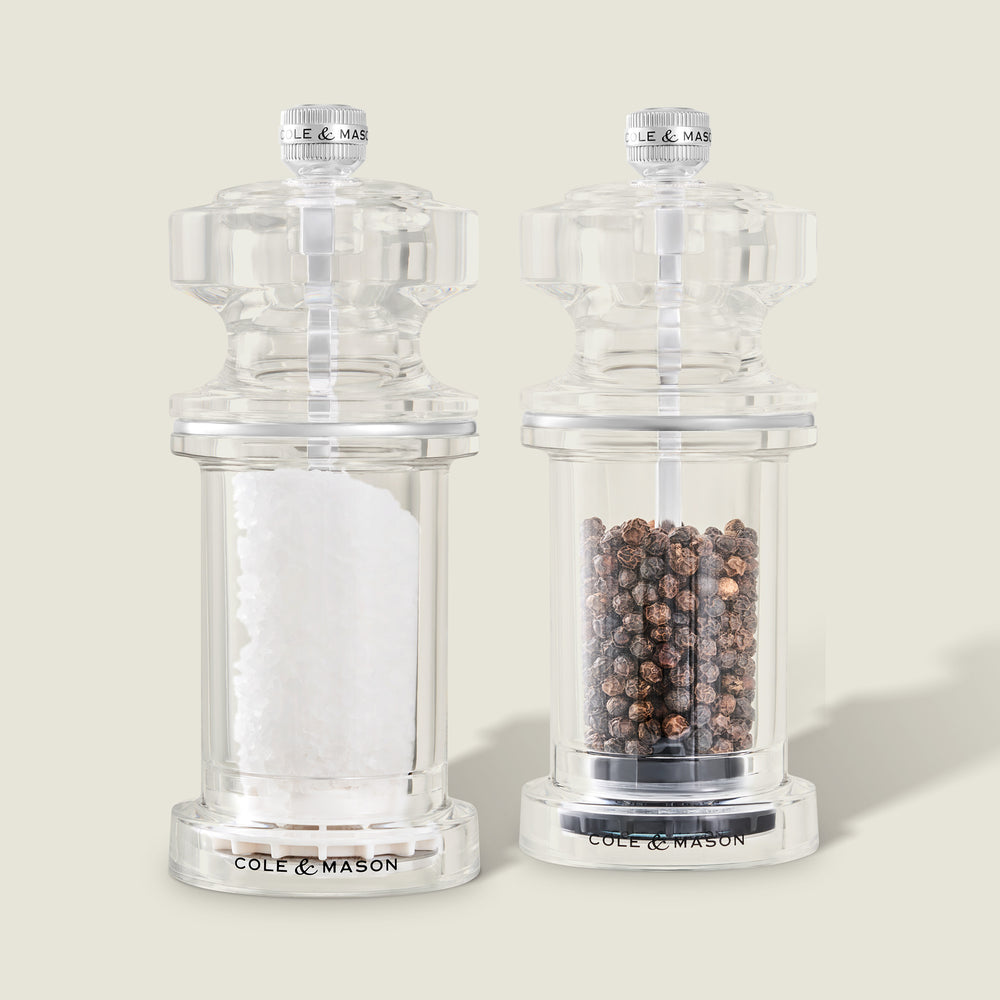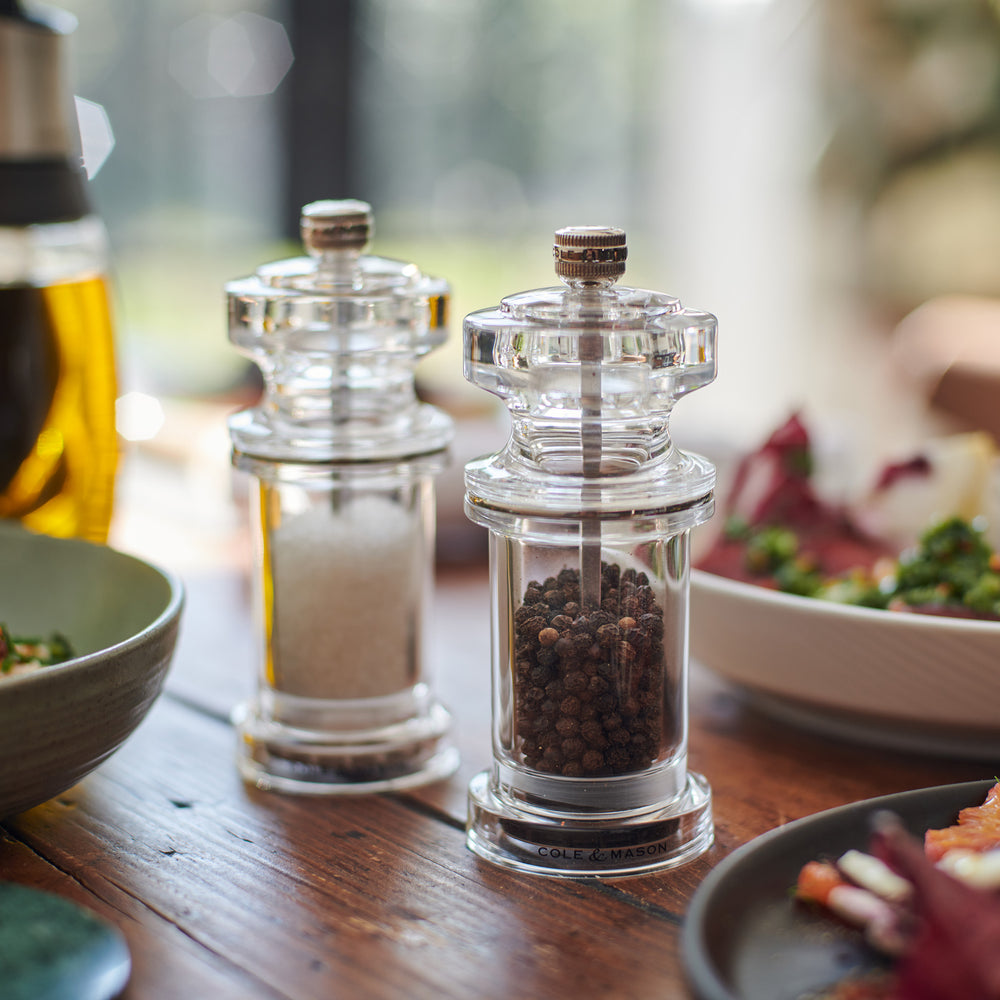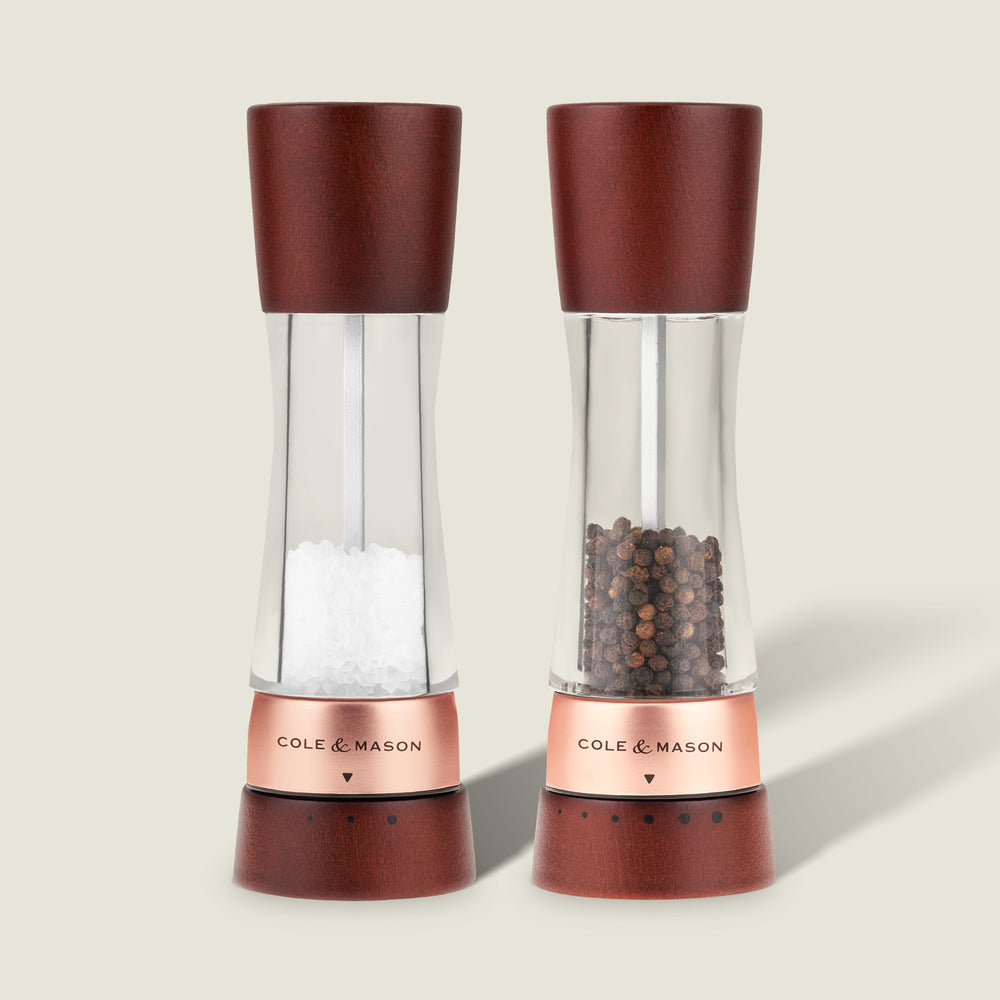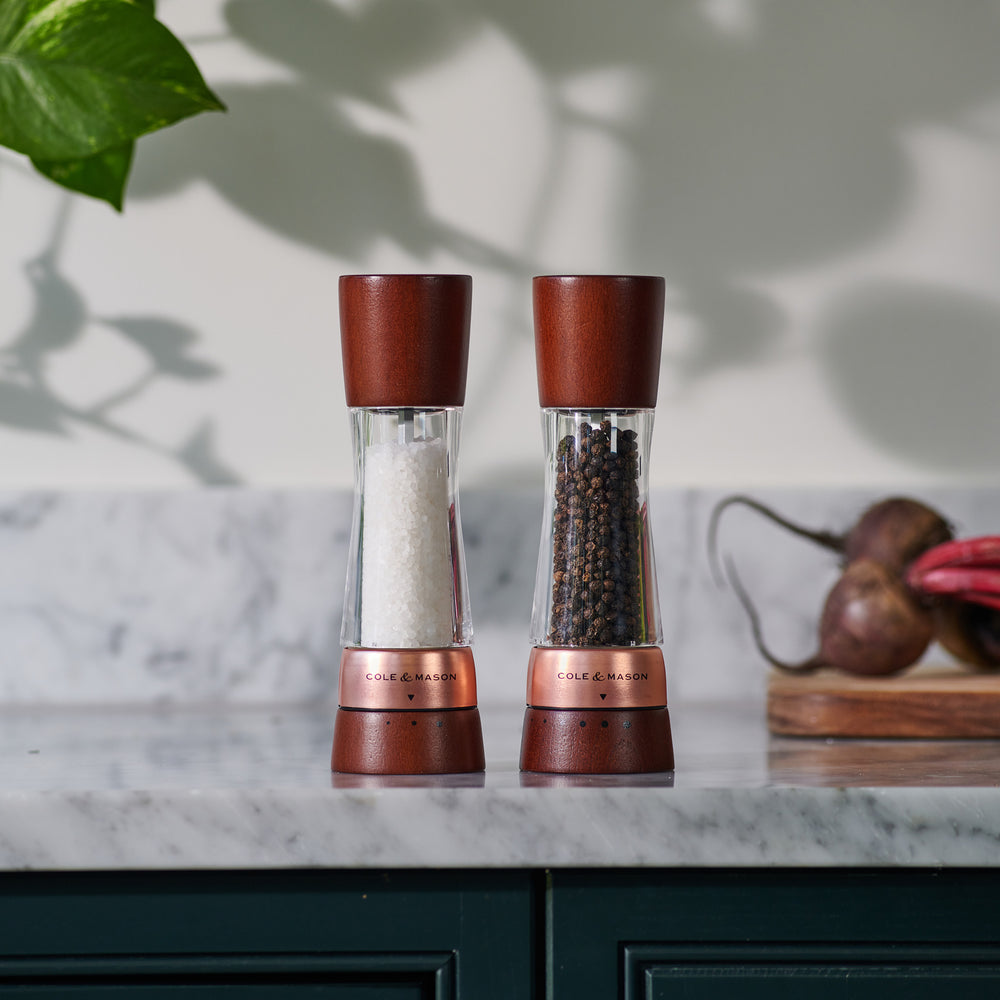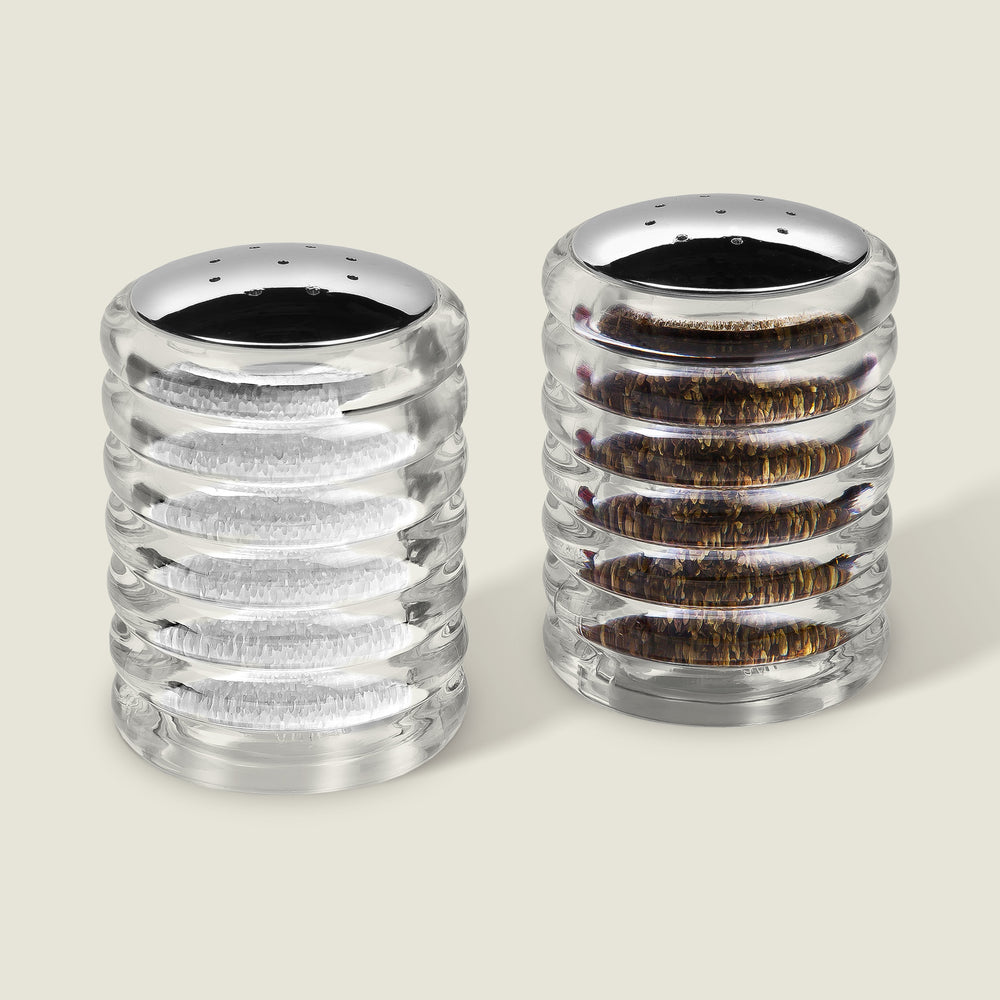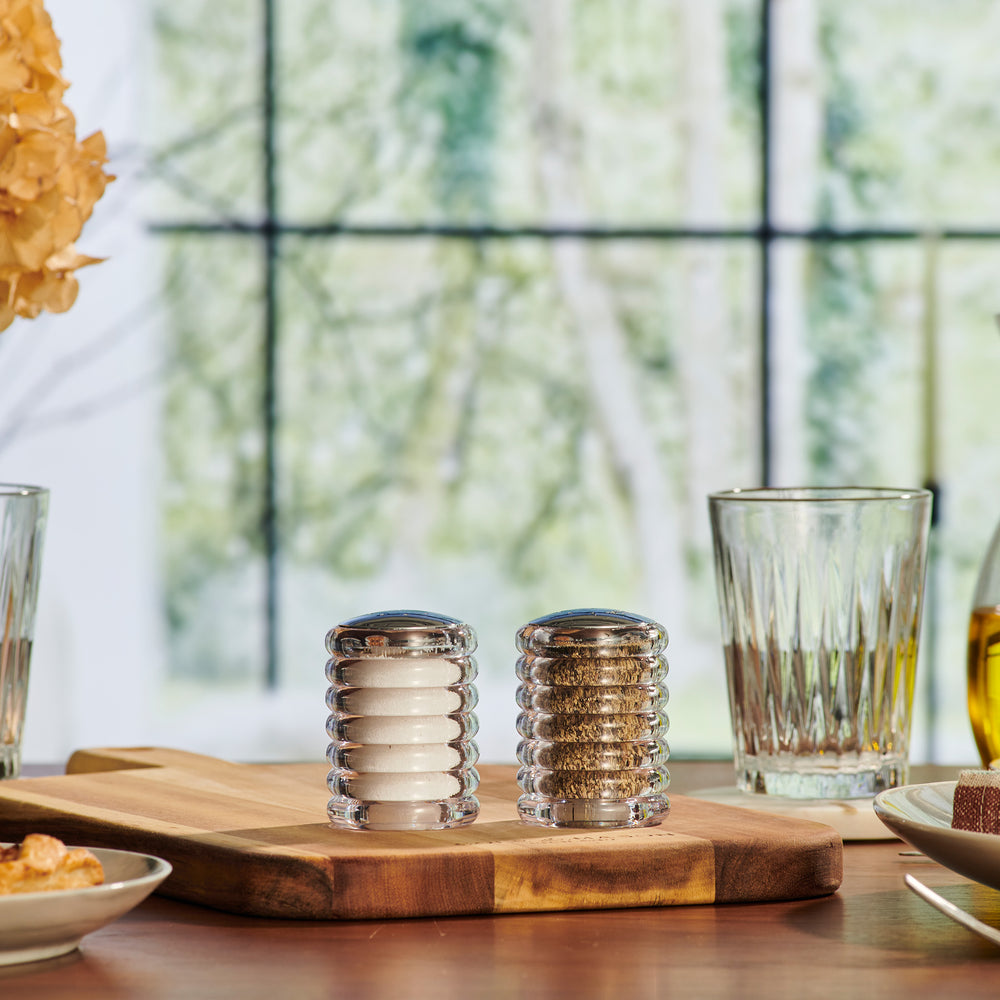Salt and pepper: the dream team. The faithful duo who add the finishing touch to any meal. Salt and pepper mills are a great way of getting the most out of your seasonings. For the tastiest flavours and textures, freshly ground salt and pepper has more of an impact than pre-ground.
But when it comes to the grind, will any old mill do? Although salt and pepper grinders may look the same, there are important differences that can affect your seasoning’s end result.
Are salt and pepper mills the same?
Salt and pepper mills are both used to grind coarse ingredients so you can sprinkle them over dishes. Manual salt and pepper grinders use a twist motion that causes blades to break down the seasoning into smaller pieces. Electronic mills grind spices at the push of a button.
Though the body of the mills may look similar (or identical), not all salt and pepper grinders are exactly the same — they can contain different mechanisms.
At Cole & Mason, we use ceramic mechanisms for salt and carbon steel mechanisms for pepper, so they are not interchangeable. We use our 100 years of expertise to create the most efficient mechanisms using some of the best materials available, which are specialised to grind either salt or pepper.
Salt mills
Salt is the ultimate flavour-enhancer. From lashings of table salt over chips to a crunchy rock salt salad garnish, a salt mill is the ideal tool for highlighting sweet and savoury nuances.
Salt mill grinding mechanisms tend to be made of ceramic or nylon. Naturally oxidised, ceramic can’t be corroded or rusted by salt. Nylon grinding mechanisms are also rust-resistant and are best suited to sea salt, which is softer and flakier than rock salt, but they can degrade over time.
Occasionally, you'll find stainless steel salt grinder mechanisms. However, those constructed from steel contain a small percentage of nickel and chromium to create a protective layer and prevent corrosion.
Our salt mills at Cole & Mason are made from white alumina ceramic, which is one of the hardest materials known to man. Non-wearing and anti-corrosive, we designed it for impeccably high precision and sharp grinding profiles. You get even grinding and consistent sharpness with zero degradation; we have a lifetime guarantee on all our mills.
Pepper mills
Freshly ground pepper is the perfect way to add a kick to your dishes. Pre-ground from a pepper shaker is convenient, but using a pepper mill gives you control over the consistency and ensures your recipe is bursting with flavour and aroma.
A pepper mill strips the crushes and strips the peppercorns, bringing out natural oils & releasing more flavour and aroma. Often, the mechanisms in pepper mills are made from carbon steel. Strong and durable, this metal can withstand hard peppercorns. Carbon steel also prevents metal from being ground along with the peppercorns.
Our Classic range of pepper mills use our incredibly strong alumina ceramic. The Precision+ and Gourmet Precision+ ranges, however, use metal. The machine-cut carbon steel in these pepper grinders have surface plating for even more corrosion resistance. The ultra-sharp mechanism differs slightly from many other pepper mills; delivering superior output, consistency and flavour.
Crushing immediately releases large quantities of pepperin oil - which imparts the pepper aroma and taste. As soon as pepper is crushed, the pepperin oil starts to lose potency. The finer the grind, the more intense the flavour. The coarser the grind, the longer the pepper flavour will last. The pepperin is released when the pepper is heated or eaten, so you get the most intense flavour when you need it most. While you can adjust the coarseness for most mills, for the best results, consider a Grind Select mill which will allow you to choose your coarseness setting for complete accuracy.
Can you grind pepper in a salt grinder, or salt in a pepper grinder?
Although they do similar jobs and look alike from the outside, salt and pepper grinders are not always fully interchangeable, depending on the material used in the mill. Essentially, you can grind pepper in most mills, but for salt you should stick to a dedicated ceramic grinder.
Salt: Salt can corrode the steel on a pepper grinder’s teeth, reducing its efficiency and leading to rust and corrosion. This can lead to clumps of salt sticking to the mechanism and making a mess. So when it comes to salt, it’s best to stick to a salt mill with a sharp ceramic mechanism for the best results.
Pepper: Peppercorns are tough little things, and the mechanisms in a salt mill are designed to break down large, soft, brittle salt granules into finer pieces. Some nylon salt grinders may struggle to crack through pepper. Ceramic salt grinders like ours are more robust and can be used to grind pepper.
At Cole & Mason our salt & pepper mills are designed to produce the best results for each of your seasonings, with specialised carbon steel mechanism for pepper, and sharp ceramic for salt. For the expert foodie, we have developed our Precision+ pepper grinding mechanism which cracks the peppercorn before grinding, allowing more flavour release with each grind. Meanwhile, our new 2025 Kenton Collection is designed to allow you to mix & match and use your mill for either salt or pepper, so features a sharp ceramic mechanism suitable for both.
How can you tell salt and pepper shakers apart?
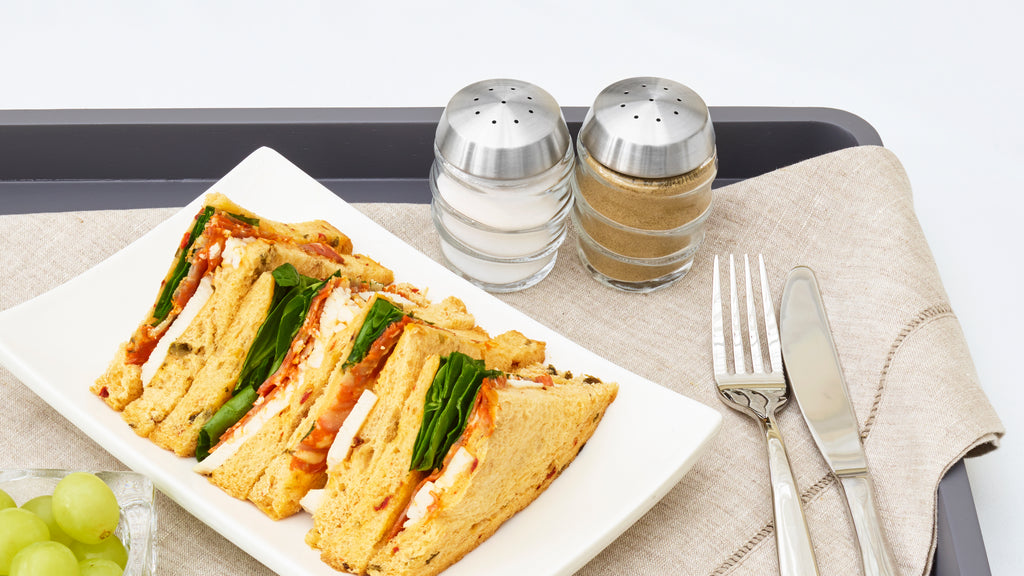
Salt and pepper shakers are ideal for quickly adding a dash of seasoning to jazz up your dish. Designed for pre-ground salt and pepper, you can just shake and go. Often, salt and pepper shakers look very similar, and you may not be able to tell them apart at first glance.
Depending on design and aesthetic, salt and pepper shakers may be distinguished from one another by the number of holes on top. In more traditional UK designs, pepper shakers have three or four holes, while a salt shaker has one or two. However, it’s really down to personal preference which seasoning you fill each with!
A practical option is to choose clear glass or acrylic shakers. That way, you can see what you’ve got right away. The same goes for salt and pepper grinders. A clear mill allows you to pick up the seasoning you need right away and also gives you a heads up on when you’re running low. For opaque mills, you may wish to go for a set that has a handy ‘S’ or ‘P’ marking on the top.
Do you clean them in the same way?
It’s quick and easy to clean salt and pepper shakers. You can simply unscrew the lids, clean the jars in warm, soapy water, and wipe the lids with a damp cloth. It’s important to dry the shakers fully before refilling to prevent the holes from becoming clogged.
Check out our full guide for cleaning salt & pepper mills.
Whether you choose a sleek electric model or a traditional wooden set, all our salt and pepper mills come with a lifetime mechanism guarantee so you can season to your heart’s content.



